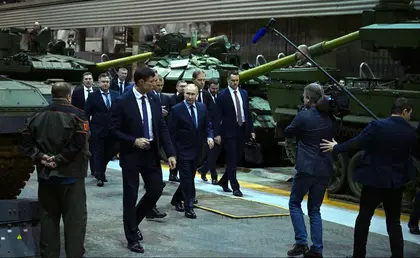CNN in its Monday “exclusive” report focuses on the numbers, saying that Russia is producing almost three times as much artillery ammunition as the combined efforts of the US and Europe in support of Kyiv.
According to an unnamed NATO intelligence official, the Kremlin is running its artillery manufacture plants “24/7.” The article suggests that the imbalance will be decisive ahead of an anticipated Russian offensive in the coming months.
JOIN US ON TELEGRAM
Follow our coverage of the war on the @Kyivpost_official.
However, according to the Wall Street Journal, in another Monday report, this view is not shared by many Western officials and analysts.
It says that in the short term, though Russia’s production figures seem impressive they may be unsustainable as it is being achieved at the cost of the wider economy.
In particular, the combined drain on available manpower from both the war and the needs of the military industry has become acute in some areas. Things were bad enough at the Uralvagonzavod tank factory in Nizhny Tagil, that it had to take on 250 convicts to make up for personnel shortages, Business Insider reported.
As a result of the failure of the full-scale 2022 invasion to reach its intended goals, Moscow rapidly depleted its weapons and ammunition stocks and plowed its resources into its arms industry. In 2020, Russia spent 14 percent of its federal expenditure on defense, which increased in 2023 to 21 percent and in 2024 is likely to exceed 29 percent.

Moldova Residents Caught in the Middle of Gas Fight
In a December interview with the Russian media site TASS, Russian Defense Minister Sergei Shoigu said that since the start of its so-called “special military operation,” his troops had 17 times more UAVs (drones), 17.5 times more ammunition, and six times more tanks, “which are being improved and modernized.”
Some NATO experts think that Russia could sustain its war effort for at least two years, based on economic figures from several military-related industries but others argue that these are misleading.
They say that much of the increase in defense-related output relates to low-tech products and many of the output figures quoted by Moscow include refurbished old equipment and ammunition which was well past its normal serviceability dates.
The UK military think tank, the Royal United Services Institute (RUSI), believes that in the long run, Russia’s domestic ammunition production won’t be sufficient to maintain its operations in Ukraine and will need to continue to get supplies from places like North Korea, and Iran.
Russia’s weapons problems do not stop at just keeping sufficient stocks to conduct its war.
A report this week by the Stockholm International Peace Research Institute (SPIRI) suggests that the poor performance of many of Russia’s weapons systems during the war in Ukraine combined with the diversion of weapons originally intended for export have had a devastating impact on Moscow’s arms sales.
According to SPIRI’s figures, Russian arms exports fell by more than 50 percent between 2019 and 2023 compared to the previous five-year period – its share of the world market falling to 11 percent.
In 2019 Russia supplied major weapons systems to 31 countries. In 2022 that number fell to 14, and to only 12 in 2023 – with India, China and Egypt being its main customers, accounting for more than 60 percent of its weapons exports.
Not surprisingly the US and France have filled much of the gap left by Russia and arms supplies to Europe have almost doubled since 2019.
Even less surprising is that the weapons and ammunition provided to Kyiv by more than 30 states with its imports representing almost 5 percent of the global total, increased from what was only about 0.1 percent in 2018.
You can also highlight the text and press Ctrl + Enter










